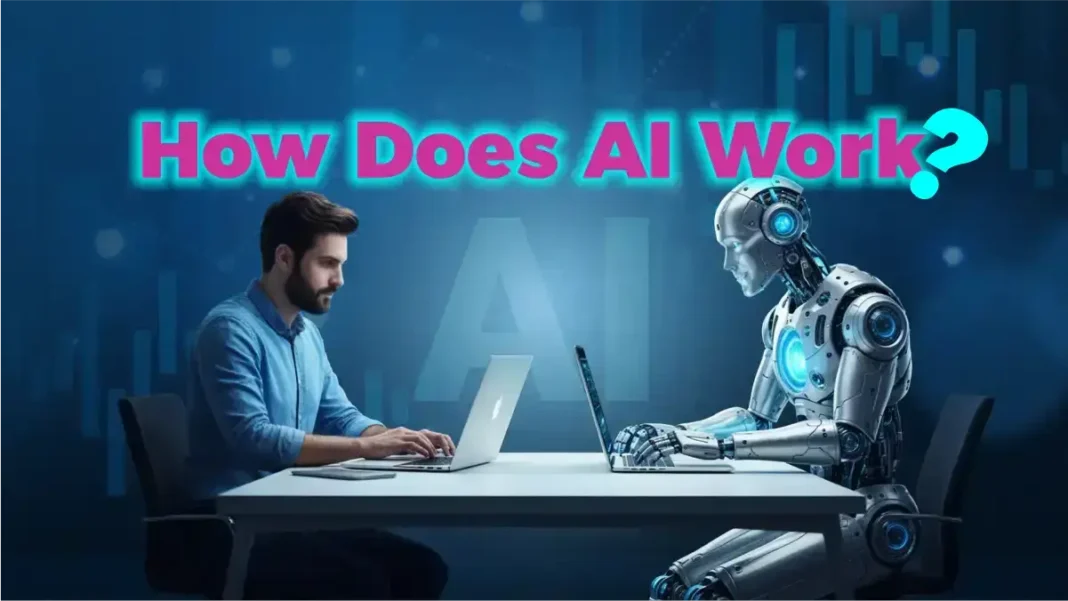Introduction: Understanding How AI Works
Artificial Intelligence (AI) is no longer a futuristic concept-it’s embedded in our daily lives, from voice assistants to self-driving cars. But how does AI work? At its core, AI mimics human intelligence using algorithms, data, and computational models. This guide breaks down the essentials of machine learning and neural networks, offering a clear path for beginners to understand the technology shaping our world.
In the first 100 words, we answer the question: How does AI work? AI systems analyze vast datasets, learn from patterns, and make decisions with minimal human intervention. Whether it’s recommending your next Netflix binge or diagnosing medical conditions, AI is revolutionizing industries.
What Is Artificial Intelligence and How Does It Work?
AI refers to machines designed to perform tasks that typically require human intelligence. These tasks include:
- Speech recognition
- Decision-making
- Visual perception
- Language translation
According to Caltech’s 2024 guide, AI operates through a combination of algorithms and models that learn from data. The more data an AI system processes, the better it becomes at predicting outcomes and solving problems.
Machine Learning: The Engine Behind AI
Machine Learning (ML) is a subset of AI that enables systems to learn from data without being explicitly programmed. It’s the driving force behind most modern AI applications.
Types of Machine Learning:
- Supervised Learning: Trains on labeled data (e.g., identifying cats vs. dogs in images).
- Unsupervised Learning: Finds hidden patterns in unlabeled data (e.g., customer segmentation).
- Reinforcement Learning: Learns through trial and error, receiving rewards or penalties (e.g., game-playing bots).
The Stanford AI Index Report 2025 highlights that ML performance on benchmarks like GPQA and SWE-bench improved by over 40% in just one year-a testament to its rapid evolution.
Neural Networks: Mimicking the Human Brain
Neural networks are inspired by the structure of the human brain. They consist of layers of interconnected nodes (neurons) that process data and learn from it.
Key Components:
- Input Layer: Receives raw data (e.g., pixels in an image).
- Hidden Layers: Perform complex computations and pattern recognition.
- Output Layer: Produces the final prediction or classification.
Deep learning, a subset of neural networks, uses multiple hidden layers to analyze data hierarchically. According to Science News Today, deep learning has enabled breakthroughs in image recognition, natural language processing, and autonomous driving.
Real-World Applications of AI in 2025
AI is transforming industries across the globe. Here are some standout applications:
- Healthcare: AI-assisted diagnostics and personalized treatment plans.
- Finance: Fraud detection and algorithmic trading.
- Education: Adaptive learning platforms and intelligent tutoring systems.
- Transportation: Autonomous vehicles and traffic optimization.
The McKinsey 2025 report estimates AI could contribute $4.4 trillion in productivity gains globally. Meanwhile, AI-enabled medical devices approved by the FDA surged to 223 in 2023, up from just six in 2015.
Challenges and Ethical Considerations
Despite its promise, AI poses challenges:
- Bias and Fairness: Algorithms can inherit biases from training data.
- Privacy: AI systems often require access to sensitive personal data.
- Transparency: Many AI models operate as “black boxes,” making decisions difficult to interpret.
The Stanford AI Index emphasizes the need for responsible AI frameworks, with global cooperation intensifying in 2024 among the OECD, EU, and African Union.
Expert Insight
Dr. Gabriel Petrea, AI researcher at POLITEHNICA Bucharest, notes:
“AI’s potential is immense, but its success hinges on ethical integration. We must balance innovation with responsibility to ensure equitable outcomes for all.”
His 2025 study in Education Sciences underscores the importance of structured frameworks and ethical guidelines in AI adoption.
People Also Asked:
What is AI and how does it work?
AI uses algorithms and data to simulate human intelligence. It learns from patterns and improves over time.
How do AI algorithms learn?
AI algorithms adjust based on experience, refining their predictions through feedback loops.
Can beginners learn AI easily?
Yes! Start with foundational topics like statistics, programming, and data structures. Platforms like IU.org offer beginner-friendly courses.
What are neural networks in AI?
Neural networks are layered structures that process data similarly to the human brain, enabling complex pattern recognition.
Conclusion: The Future of AI Is Now
Understanding how AI works is the first step toward engaging with one of the most transformative technologies of our time. From machine learning to neural networks, AI is reshaping industries, enhancing productivity, and challenging us to think ethically about innovation.
Whether you’re a curious beginner or a budding technologist, the journey into AI starts with asking the right questions-and now, you have the answers.


